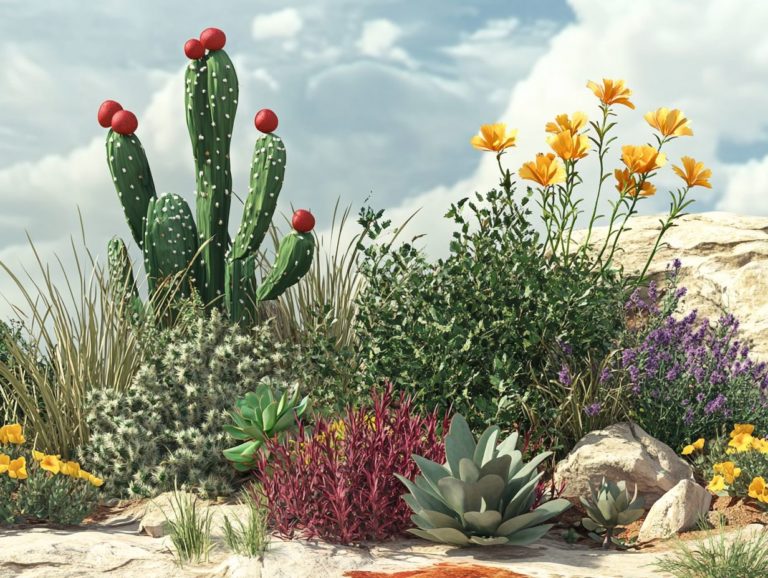Top 10 Common Edible Weeds
When you think of weeds, it s easy to picture those pesky plants trying to take over your garden. However, many of these so-called nuisances are actually nutritious and delicious edibles just waiting for you to discover them!
This article highlights ten common weeds you can eat, like dandelion and chickweed, showcasing their health benefits and ways to use them in cooking. It delves into misconceptions, offers safety tips, and shows you how to incorporate these vibrant greens into a sustainable diet.
Join us in exploring the hidden gems of nature!
Contents
- Key Takeaways:
- 1. Dandelion
- 2. Purslane
- 3. Chickweed
- 4. Clover
- 5. Lambsquarters
- 6. Plantain
- 7. Nettles
- 8. Wild Garlic
- 9. Burdock
- 10. Chicory
- What Are Edible Weeds and How Are They Beneficial?
- Are All Weeds Edible?
- What Are the Nutritional Benefits of Edible Weeds?
- How Can Edible Weeds Be Prepared and Used in Cooking?
- What Are the Common Misconceptions About Edible Weeds?
- Are There Any Safety Concerns When Consuming Edible Weeds?
- How Can One Safely Identify and Harvest Edible Weeds?
- What Are Some Other Lesser-Known Edible Weeds?
- How Can Edible Weeds Be Incorporated into a Sustainable Diet?
- Frequently Asked Questions
Key Takeaways:
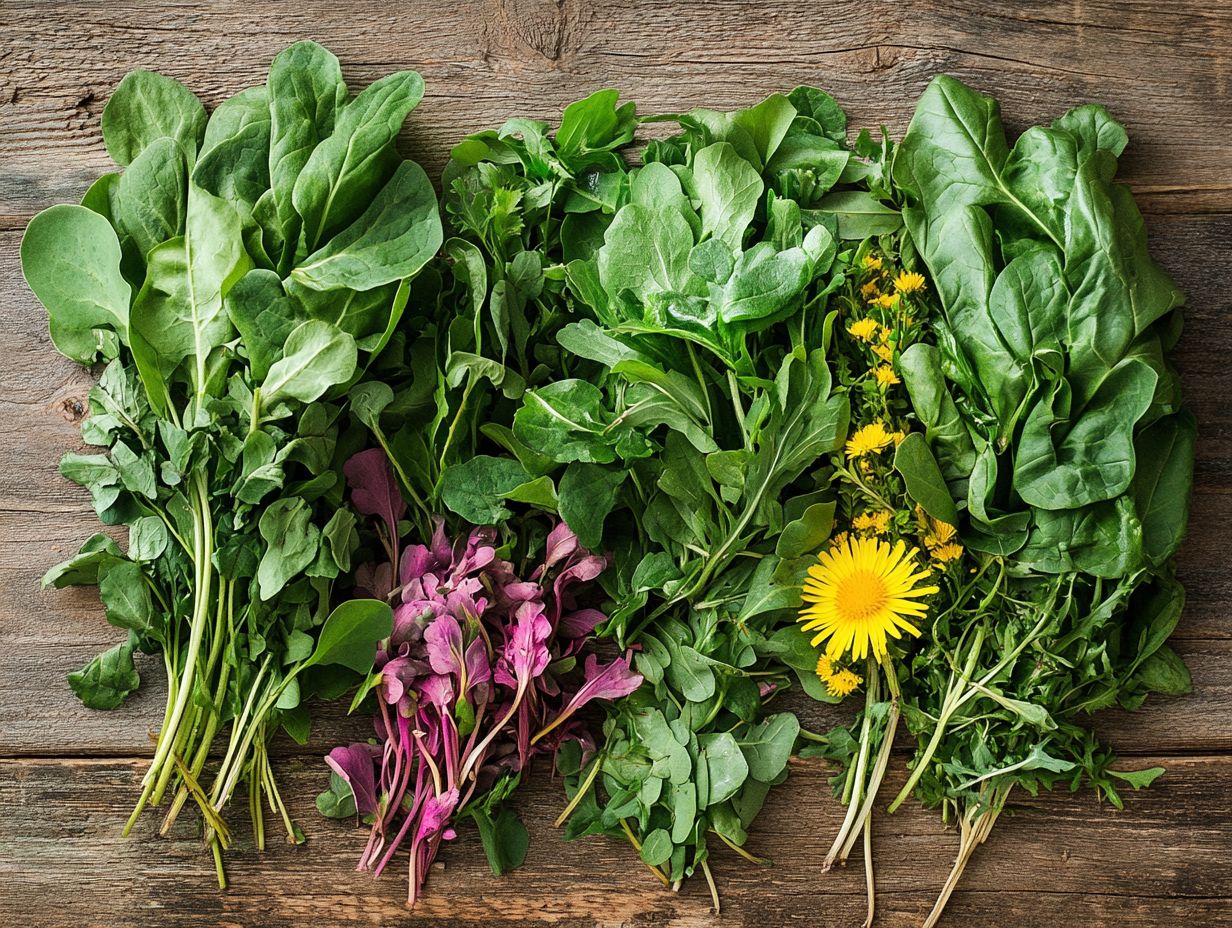
- Not all weeds are bad! Dandelion, Purslane, chickweed, and clover are just some of the common edible weeds that provide nutritional benefits and can be easily incorporated into meals.
- Edible weeds are rich in vitamins, minerals, and antioxidants. They can be used in salads, saut ed, or even made into pesto.
- Always check carefully when picking weeds to avoid toxic look-alikes. Always research and properly identify before consuming.
1. Dandelion
The Dandelion plant (Taraxacum officinale) is a remarkable and nutritious edible treasure often dismissed as a mere weed. This versatile plant can elevate your culinary creations and offer impressive medicinal benefits, making it a beloved choice for gardening enthusiasts and foragers alike.
Its leaves are bursting with vitamins A, C, and K, perfect for enhancing fresh salads or saut ing as a delightful side dish. The vibrant Purslane flowers can be transformed into dandelion wine or even incorporated into fritters, creating a unique appetizer that sparks conversation.
The roots present a wonderful opportunity to craft a caffeine-free coffee substitute, delivering not only rich flavor but also digestive health benefits. For those who enjoy experimenting in the kitchen, dandelions can add a depth of flavor to wild recipes, infusing a touch of earthiness that pairs beautifully with a variety of ingredients while promoting wellness through their anti-inflammatory properties (which help reduce inflammation) and antioxidant properties (which protect your body from damage).
2. Purslane
Purslane (Portulaca oleracea) is a succulent edible plant brimming with nutrients, including omega-3 fatty acids, vitamins, and minerals. You might spot it in gardens and backyards, often mistaken for a common weed. But don t let that fool you; it s easy to recognize and perfect for cooking experiences.
Its unique, slightly tart flavor makes purslane a delightful addition to a range of dishes. Whether you toss it into salads for a refreshing crunch or saut it in stir-fries, its texture holds up beautifully. Rich in antioxidants and essential vitamins, this vibrant green not only boosts the nutritional profile of your meals but also adds a lovely pop of color.
Finding purslane in the wild is quite straightforward. Just look for its sprawling, thick stems and fleshy leaves, typically thriving in sunny spots. You can enjoy this exceptional plant fresh in salsas or blended into smoothies, showcasing its status as an underappreciated powerhouse of nutrition that can elevate your everyday meals.
3. Chickweed
Chickweed (Stellaria media) may appear to be just another common weed, but don t let its humble reputation fool you. This tender, leafy plant is an edible gem, brimming with nutrients and ready to elevate your culinary creations. It s truly a valuable addition to any forager’s toolkit.
With a light and sweet taste, chickweed pairs beautifully in salads, sandwiches, or as a delicate garnish. Beyond its culinary appeal, it offers a bounty of health benefits. Packed with vitamins A, C, and various B vitamins, alongside essential minerals like iron and calcium, chickweed promotes overall wellness.
For those eager to experiment with wild recipes, this versatile green can be blended into pesto or tossed into soups for an enriching boost. When foraging, keep an eye out for its small, oval leaves that grow in whorls along the stem, complemented by its charming star-like white flowers.
The best time to harvest is in the spring when the leaves are young and tender, ensuring you enjoy the freshest flavor and maximum nutrient content. Consider using harvesting tips for optimal results.
Try these edible weeds in your next meal and discover their amazing flavors!
4. Clover
Clover, particularly Red Clover (Trifolium pratense), is not just a common garden weed but an edible plant that showcases impressive medicinal properties. It can be seamlessly integrated into various culinary dishes, making it a valuable resource for anyone passionate about sustainable gardening and herbalism.
Other varieties, such as White Clover (Trifolium repens) and Sweet Clover (Melilotus officinalis), bring their own unique flavors and health benefits to the table. Whether fresh or dried, these clovers can elevate salads, smoothies, and soups, adding a delightful twist to your meals.
Clovers are rich in nutrients, especially isoflavones. They can support hormonal balance and heart health.
Traditionally, clovers have been utilized in folk medicine to treat a range of ailments, including respiratory infections and skin conditions.
When you’re preparing clovers for consumption, it s crucial to identify them correctly. Keep an eye out for their distinct three-leaflet structure and sweet aroma to ensure you ve harvested the right variety.
5. Lambsquarters
Lambsquarters (Chenopodium album) is an edible gem that often graces your garden as an uninvited weed. Don’t miss out on this nutritious green; it’s a must-try for any forager!
This resilient green is packed with vitamins A and C, along with essential minerals like calcium and iron. Its mild, spinach-like flavor elevates a range of dishes from fresh salads to hearty soups.
Culinary enthusiasts love its versatility, tossing it into stir-fries or blending it into smoothies for a nutritious boost. Beyond its culinary appeal, Lambsquarters also offers several health benefits, including anti-inflammatory and antioxidant properties.
If you re planning to forage for this plant, proper identification is essential. Look for the distinct mealy white coating on the underside of its leaves and steer clear of similar-looking impostors.
When you’re out gathering, opt for the younger leaves they’re more tender and flavorful. And remember to forage in a clean, pesticide-free area to ensure the best quality.
6. Plantain
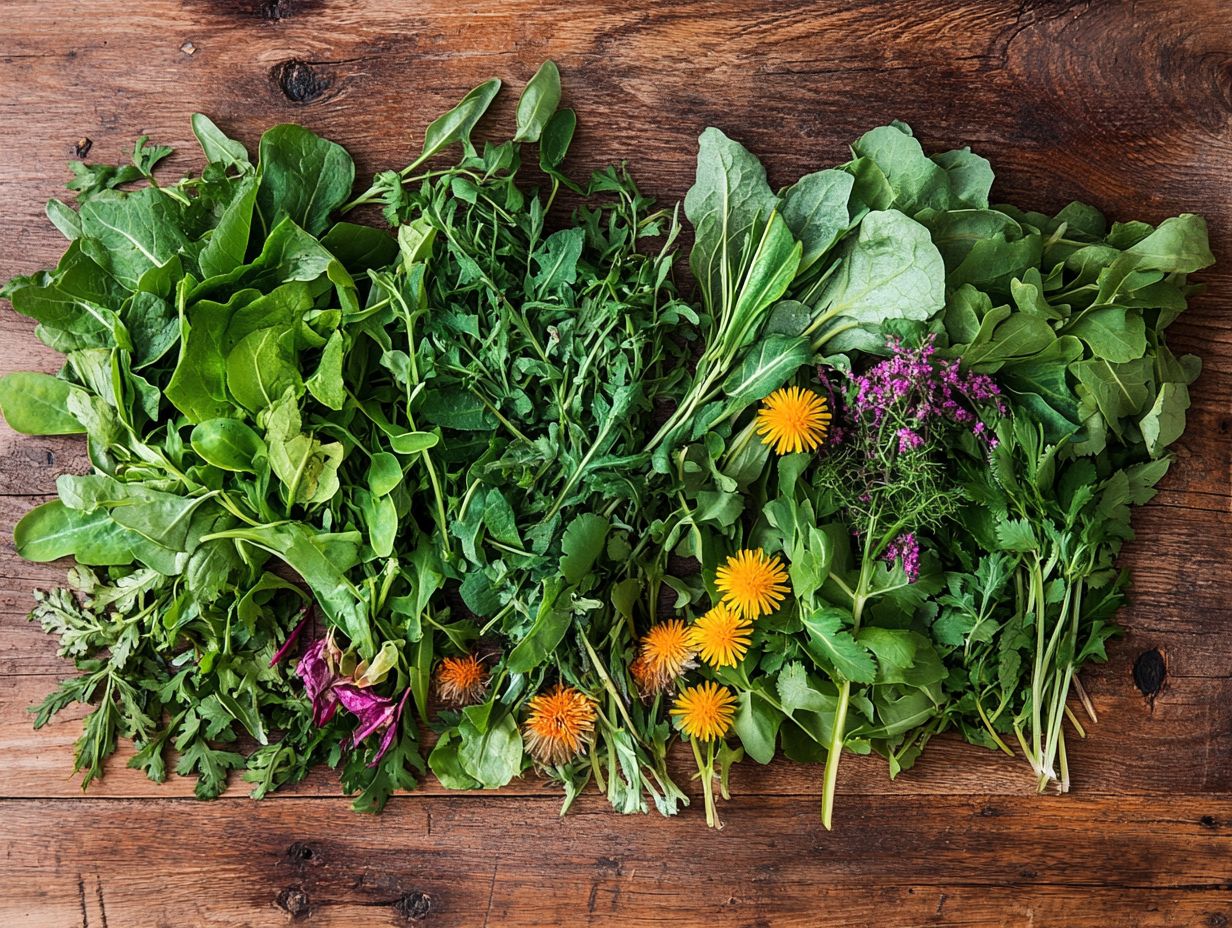
Plantain (Plantago spp.) is a hidden treasure that may be thriving in your own backyard or garden. Its nutritious leaves not only elevate your culinary creations but also serve as natural remedies for a variety of ailments.
These versatile leaves come in several varieties, each tailored for distinct culinary purposes from crafting savory dishes to brewing herbal teas. With their unique taste and texture, plantain leaves become a delightful addition to salads, stews, and wraps.
On the health front, this plant is rich in antioxidants and boasts anti-inflammatory properties, offering relief for issues like indigestion and respiratory discomfort.
You can also harness the soothing qualities of plantain leaves to alleviate insect bites and minor skin irritations through natural remedies. If you re considering incorporating plantain into your garden, remember to harvest the leaves early in the morning when they are most fresh and flavorful. Thoroughly wash and prepare them to maximize their flavor and benefits.
7. Nettles
Nettle leaves (Urtica dioica) are a nutrient-rich edible plant you might encounter in the wild. They are celebrated for their culinary versatility and impressive health benefits, despite that initial sting when fresh.
These vibrant green leaves are packed with vitamins A, C, and K, along with essential minerals like iron and calcium. They make a valuable addition to your diet.
You can incorporate them into a variety of dishes, from hearty soups and stews to refreshing smoothies and zesty pesto, boosting both flavor and nutrition. Just remember, when cooking, it’s crucial to briefly cook them in hot water or stir-fry them to neutralize their sting.
If you re keen on foraging, make sure to don some gloves while harvesting to avoid the nettles’ pesky irritating hairs. Aim to collect them from clean, pesticide-free areas to ensure your safety.
With the right preparation, nettles can be a nourishing and delightful enhancement to your meals, especially when considering their culinary uses in various recipes.
8. Wild Garlic
Wild Garlic, often called Garlic Mustard (Alliaria petiolata), is an edible plant that adds a unique flavor to your meals. It s a prized ingredient in various dishes and offers impressive health benefits, similar to edible flowers.
You ll love its vibrant green leaves and delicate white flowers, which enhance salads, soups, and sauces with a subtle garlic essence. This wild edible is also packed with health perks, including antibacterial properties and a wealth of vitamins A and C.
When foraging, look for its heart-shaped leaves that release a delightful garlicky aroma when crushed. For the best flavor, harvest it in the spring before it flowers, when the leaves are at their most tender and flavorful.
9. Burdock
Burdock (Arctium lappa) is an extraordinary edible plant to explore, especially for its nutritious root. This impressive ingredient not only offers a range of health benefits but has also been significant in traditional medicine, making it a great find for anyone looking to forage or garden sustainably.
The root can be skillfully incorporated into various dishes, celebrated for its distinct flavor and satisfying crunch. It enhances everything from stir-fries to soups, where slicing it thinly adds delightful earthiness to your meals. Pair it with other nutritious greens for a balanced dish.
On the medicinal side, burdock root is known for its detoxifying properties, meaning it helps clear toxins from the body. It’s often used to support liver function and purify the blood. You can brew it into soothing teas or enjoy it as a tonic.
When harvesting, seek out healthy, young roots in the fall, as they thrive best when pulled from moist, nutrient-rich soil. For cooking, consider methods like steaming or simmering, which highlight the root’s natural flavor while preserving its essential nutrients. Understanding soil conditions is key for successful harvesting.
Don t miss out on the chance to discover this delicious plant! Get out there and start foraging these incredible plants today!
10. Chicory
Chicory (Cichorium intybus) is an intriguing edible plant worth adding to your culinary repertoire. Its leaves and roots are celebrated for their versatility in dishes and natural remedies.
Chicory offers impressive health benefits, especially for wild food enthusiasts. You can enjoy Chicory leaves in salads, which add a pleasantly bitter crunch.
Harvest young leaves for salads, while older ones are best cooked to reduce bitterness. Cooking enriches their earthy flavor, and don’t forget to add edible flowers for a colorful touch.
As for the roots, roasting and grinding them creates a delightful coffee substitute with a rich, nutty flavor. Chicory is also packed with nutrients, including inulin, a type of fiber that helps with digestion.
To identify chicory, look for its striking blue flowers and jagged leaf margins. The best harvesting time is in the spring or early fall, just before flowering.
What Are Edible Weeds and How Are They Beneficial?
Edible weeds may seem like mere nuisances in your garden, but they’re actually nutritious plants. For those interested in foraging, learning about the top 10 edible plants to harvest sustainably can reveal their impressive health benefits and culinary versatility.
Many common weeds surprise with their rich flavors. Think of dandelions, nettles, and purslane, which are packed with vitamins and minerals. Additionally, exploring top 10 wild fungi you can eat can further enhance your culinary adventures.
These greens often contain more nutrients than cultivated vegetables. Foraging reduces reliance on commercially grown produce, which has a larger carbon footprint.
The culinary possibilities are virtually endless! You can toss them into salads, blend into smoothies, or create a delightful pesto.
Always ensure proper plant identification to avoid harmful look-alikes. Use Chickweed flowers and Purslane flowers for vibrant dishes.
Are All Weeds Edible?
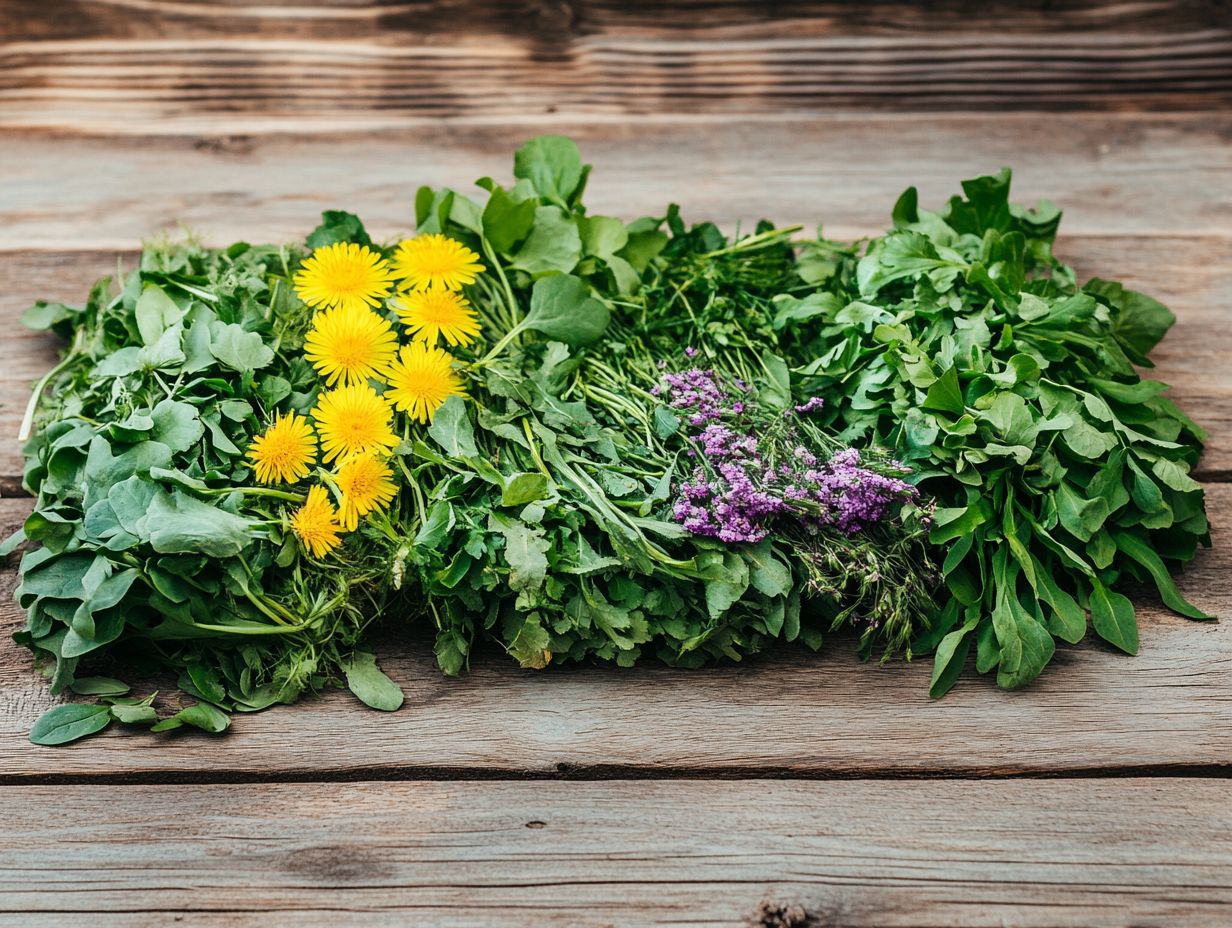
While many common weeds boast edibility and nutritional value, not all are safe for your plate. Precise plant identification is crucial, and it’s wise to seek guidance from gardening experts who can help differentiate between edible varieties and invasive plants like Knotweed.
Understanding the distinguishing characteristics of these plants is essential for safe gathering of food from nature. When you explore wild greens, consult reliable resources or reputable foragers to learn about the appearance and habitat of various weeds, including Blackberry fruit and Mulberry tree.
Features such as leaf shape, flower color, and growth patterns help determine which weeds are indeed edible think dandelions and purslane and which to avoid, like pokeweed and nightshade. Recognizing Curly Dock can also enrich your knowledge.
It’s crucial to consider local pollution. Some weeds may absorb harmful substances from their environment, making even typically edible ones risky if they grow in contaminated areas. Stay informed and cautious to enjoy safe foraging, especially regarding invasive plants that thrive in polluted locales.
What Are the Nutritional Benefits of Edible Weeds?
Edible weeds are packed with vitamins, minerals, and antioxidants. They serve as an excellent source of nutritious greens that can enhance your diet while supporting sustainable gardening practices. Incorporating nutritious greens like Plantain leaves can diversify your meals and boost your health.
These remarkable plants are often underestimated as mere nuisances, yet they boast an impressive array of nutrients, including vitamin C, iron, and omega-3 fatty acids. For instance, dandelion greens are rich in calcium and high in fiber, promoting healthy digestion. Consider pairing them with Nettle leaves for a balanced meal.
Incorporating these edible weeds into your daily meals is simple and exciting. Try tossing them into a fresh salad, blending them into your favorite smoothies, or sautéing them with garlic for a delightful side dish. Embrace these nutrient-dense options for unique flavors and health benefits. To get started, check out the top 5 wild edibles for beginners and explore innovative cooking methods to elevate your dishes!
Explore your garden today! You might be surprised by what you can find that s both tasty and nutritious.
How Can Edible Weeds Be Prepared and Used in Cooking?
Edible weeds can be a delightful addition to your culinary adventures, and it’s important to know the top 10 wild plants everyone should recognize. They offer a range of flavors and textures that can elevate everything from salads to soups.
These vibrant greens introduce unique tastes and provide a wealth of nutrients. For example, lightly saut dandelion leaves with garlic for a flavorful side dish.
Don t overlook nettles; they add earthiness to soups. Just remember to wear gloves until they are cooked.
Sourcing these weeds locally is eco-friendly. Consider incorporating wild fennel for extra flavor.
What Are the Common Misconceptions About Edible Weeds?
Many misconceptions about edible weeds stem from misunderstanding their nutritional value. These versatile plants can be enjoyed safely with proper plant identification.
In reality, many edible weeds are packed with vitamins and minerals. For instance, dandelion greens contain more iron and calcium than some cultivated vegetables.
People often see them as nuisances. Yet, in culinary circles, they are valued for their unique flavors and textures.
Exploring local foraging could reveal a treasure trove of flavors, like daylily shoots and elder flowers, ready to enhance your dishes.
Start experimenting today and discover delicious flavors you never knew existed!
Are There Any Safety Concerns When Consuming Edible Weeds?
Despite the many health benefits that edible weeds can provide, it s essential to consider important safety concerns, particularly when it comes to proper plant identification and the risk of contamination. This underscores your need for guidance from gardening experts to help you navigate the challenges of invasive plants.
When you venture into foraging for these green treasures, a deep understanding of their characteristics becomes crucial. Some plants can closely resemble toxic varieties, which can lead to serious health implications. Environmental factors like pollution or pesticide exposure can also turn otherwise safe plants into harmful options for consumption, especially invasive plants.
If you re interested in incorporating edible weeds into your diet, prioritize consulting reliable sources, including guidebooks, local botanical groups, and expert-led workshops focused on foraging and the uses of local wild plants.
This will ensure you embark on a safe and enjoyable exploration of the many benefits these plants have to offer, as well as practical cooking methods to utilize them effectively.
How Can One Safely Identify and Harvest Edible Weeds?
Safe identification and harvesting of edible weeds require a keen understanding of plant characteristics, when to find them, and types of weeds. This knowledge allows you to confidently select and enjoy these nutritious offerings while minimizing risks.
Start by familiarizing yourself with common edible weeds like dandelions and purslane. Pay attention to their distinct leaf shapes, flower structures, and growth habits. Observing how leaves are positioned whether they grow in a rosette or along a stem will provide valuable clues for identification. Timing is also key, as some weeds become more palatable at different stages of growth.
Always double-check your finds against reliable guides or apps before indulging. When harvesting, ensure you use clean tools, take care to protect the local ecosystem, and collect only from areas free of pollutants. This approach guarantees a safe and sustainable foraging experience that you can truly enjoy, especially as you explore the amazing world of nutritious greens around you.
Start your adventure with edible weeds today!
What Are Some Other Lesser-Known Edible Weeds?
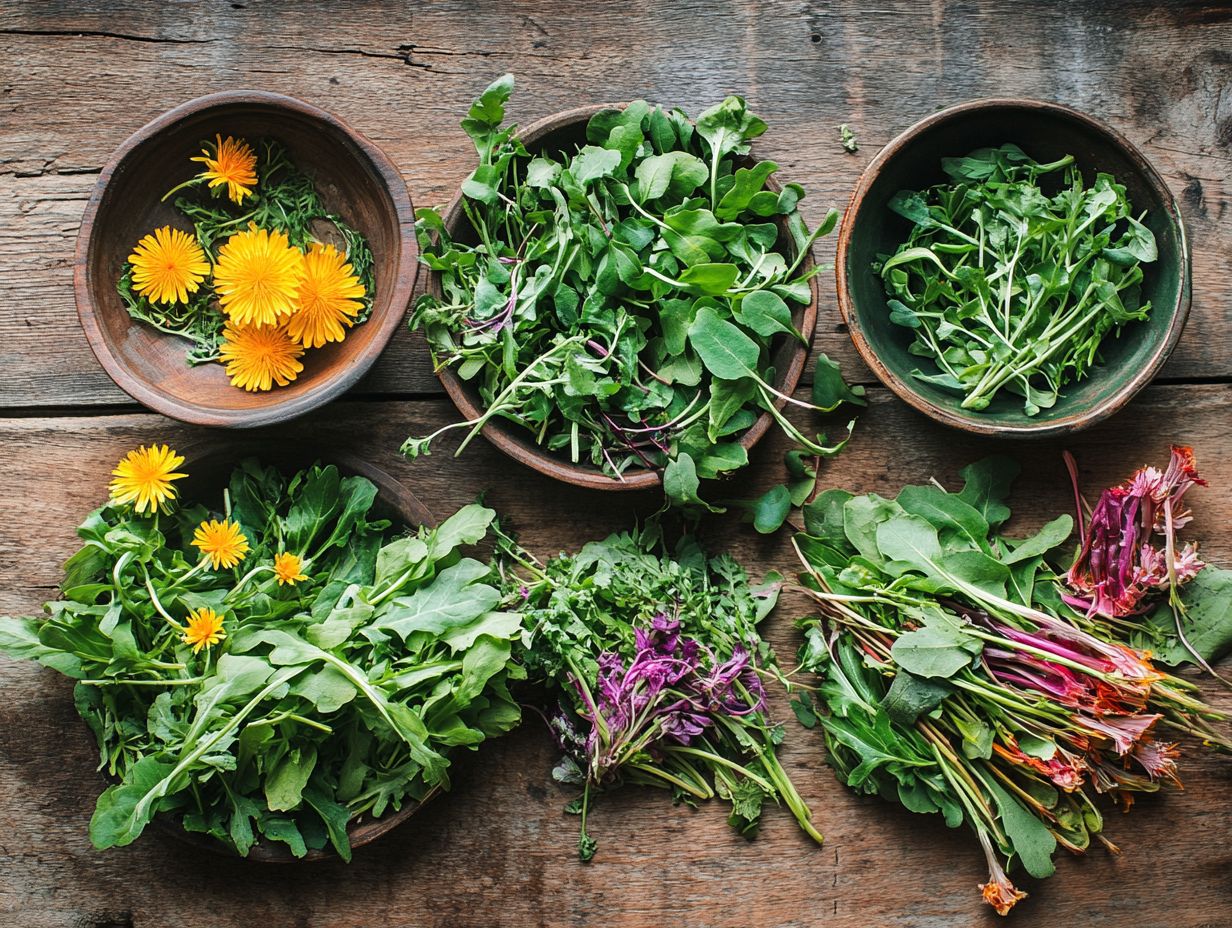
Alongside the common edible plants you know, there’s a delightful array of lesser-known edible weeds. These plants that grow where they aren’t wanted reveal a world of culinary potential, including options like the top 10 edible plants in the Great Plains, just waiting to be explored.
Venturing into this realm of unassuming plants can unlock a new dimension of taste and health for you. Take purslane, for example it s often seen as a pesky garden invader, but it has a crispy texture and is rich in omega-3 fatty acids, which are good for heart health. You can toss it into salads easily or add it to stir-fries for an unexpected twist.
Then there s lamb s quarters, or Lambsquarters, which may resemble spinach but offers a distinct flavor that elevates a variety of dishes. Identifying these plants is easy purslane flaunts thick, fleshy leaves, while lamb s quarters sport a soft, powdery coating.
Encouraging adventurous eaters like you to forage responsibly can lead to delicious discoveries right in your own backyard, especially when exploring wild food.
How Can Edible Weeds Be Incorporated into a Sustainable Diet?
Incorporating edible weeds into your sustainable diet helps your health and champions environmental sustainability. You can use readily available wild plants, including garden weeds, instead of conventional crops.
By foraging these nutritious plants that thrive abundantly around you, you can reduce your reliance on commercially grown produce and significantly decrease your carbon footprint. Many of these nutritious greens, like dandelions and purslane, are packed with essential vitamins and minerals that boost your overall well-being.
To enhance their flavors, try simple cooking methods like saut ing them with garlic and olive oil, or adding them to your soups and stews. These methods will unlock incredible flavors that you ll love!
Even blending them into smoothies or tossing them into salads can create vibrant wild recipes that celebrate nature s pantry.
Frequently Asked Questions
What are the top 10 common edible weeds and types of weeds?
- Dandelion
- Purslane
- Chickweed
- Lamb’s quarters
- Plantain
- Stinging nettle
- Burdock
- Clover
- Amaranth
- Wild onion
Some of these, like Garlic Mustard and Nettle, have exceptional medicinal properties.
Are these weeds safe to eat?
Yes, these weeds are safe to eat as long as they have not been sprayed with pesticides or herbicides. It’s crucial to properly identify the weeds before consuming them to ensure they are edible.
What are the benefits of eating these weeds?
Eating these weeds can provide a variety of nutrients and vitamins, including vitamin C, iron, and antioxidants. They can also help improve digestion and boost immune system function, contributing to overall health benefits.
How can I incorporate these weeds into my diet?
These weeds shine in salads, soups, stir-fries, and smoothies, showcasing their diverse culinary uses. They can also be saut ed or added to sandwiches or wraps. Get creative and experiment with different recipes, especially with seasonal greens!
Are there any precautions I should take when foraging for these weeds?
When foraging for these weeds, like Blackberry and Daylily shoots, ensure you’re in clean areas free of pollutants. Always wash and cook the weeds properly before consuming them.
Can I find these weeds in my backyard?
It’s possible to find these weeds in your backyard, especially if you have a lawn or garden. Species such as Japanese Honeysuckle and Curly Dock are often seen. However, be cautious if you have pets or use chemical treatments on your lawn or garden.




